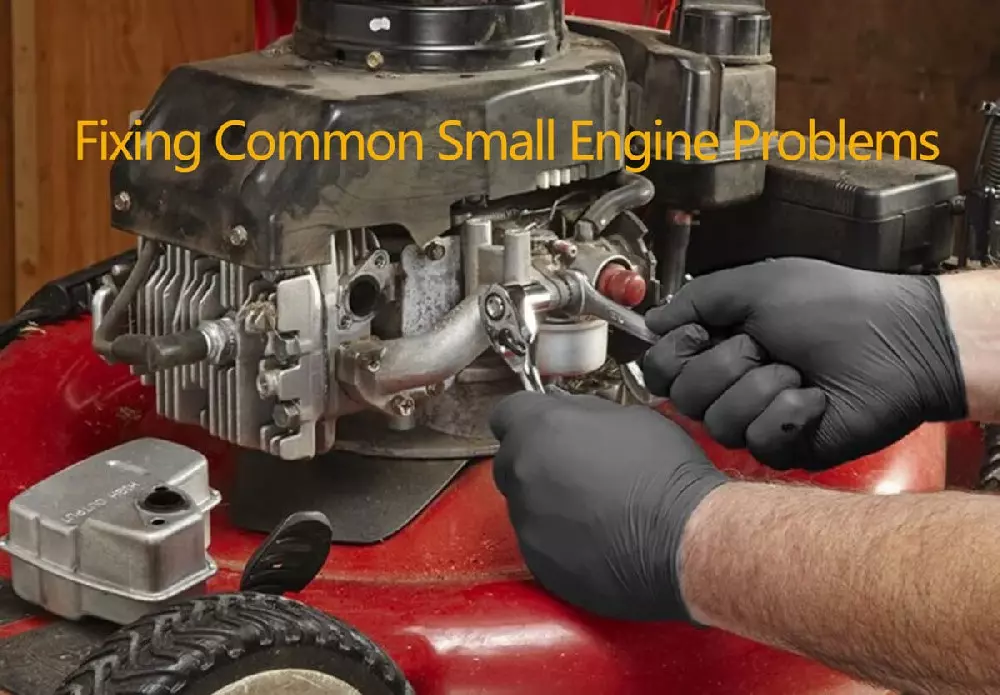fixing common small engine problems
2023-06-06
Table of content

If you’re having trouble using a small engine, we know how frustrating it can be. We'll show you how to revitalize your little engine in this tutorial, as well as when to give up and start hunting for a replacement. Learn how to fix common small engine problems with this in-depth guide by BISON. Let’s get started.
Small engine checklist for quick fixes
Before diving deep into the small engines, check out the following basics:
Is the tank full of fresh gasoline/diesel?
Are all safety devices/switches disconnected?
Are you using the correct starting procedure?
Are the spark plugs dry or wet?
Is the equipment adjusted?
Is there any smoke?
Common small engine problems
Below, we’ve listed some of the most common causes of small engine failures.
Bad gasoline/diesel
If your small engine seems to be having trouble starting or is running rough, checking the condition of your fuel is one of the most straightforward fixes you can make.
Gasoline goes bad quickly and is more likely to damage equipment than anything else. Never use fuel older than one month. Adding fuel stabilizers to fresh gasoline is good practice.
If you suspect your machine has expired fuel inside, replace it with a fresh one and add starter fluid to the carburetor a few times; it should come back to life.
Can’t breath
Arguably the easiest maintenance item is changing the air filter. However, if neglected for long periods, a failing air filter can wreak havoc on an engine’s pistons and cylinder walls until it stops in its tracks.
Dirty air filters are often overlooked, and a powerful air filter is a critical component of your small engine. If you want your engine to work longer, it’s essential to perform the quick and easy task of changing your air filter as soon as it gets dirty.
Run rough
Motors that run rough and emit a lot of smoke may need tuning. White smoke from the engine can be caused by incomplete combustion, where unburned fuel is used up. A more severe problem is oil leaking into the cylinders due to worn piston rings or, worse, a cracked engine block.
For this fix, we’ll focus on tweaking your device.
In most cases, tuning is pretty simple:
Wash the machine.
Change spark plugs, oil, fuel, and air filters.
Give the carburetor a thorough clean.
However, if your engine’s performance does not improve after a complete tune-up, it could be a sign of a more severe problem that may require an engine replacement.
Too much fuel
Most commonly, improper starting, “flooding,” is caused by various causes, including excessive oil suction, choke valve closing, valve sticking, carburetor sticking, or an immediate attempt to restart an auto-choke engine.
Removing the spark plugs is the easiest way to tell if an engine is full of gas.
If it's wet, the cylinder is flooded, and you must wait for it to dry out before attempting to restart. The procedure can be sped up with compressed air.
Sparks problems
If your engine gets enough fuel and air but won’t start, the problem may be a lack of spark.
The spark plug may be internally cracked after being dropped or subjected to severe vibration, the electrode gap may be incorrect, or the ignition module/spark plug wire may be faulty.
Check the ignition module if the engine still doesn’t start after replacing the spark plugs.
Quickly judging whether the module is bad is removing the spark plug protective cover and pulling the cable several times to see if there is an arc. An arc will be created in the gap between the end of the spark plug and the guard. If there is no arc, the ignition module needs to be replaced.
Overheating
Overheating can result from oil, fuel, fan, or gas cap failure. A mix of all these systems can also cause overheating. Multiple steps may be required to fix the problem.
Low oil level: The oil acts as a coolant, helping to carry heat away from the combustion chamber. Without the heat absorbed by the fluid, the transfer cannot occur. Change or top up the oil to the specified level required by the engine.
Dirty engine: A dirty engine does not allow hot air to escape from the engine. Use an engine dirt cleaner to remove dirt from engine surfaces.
Damaged fans: Fans on most small engines are prone to be moved, dropped, and bumped. If the fan or fan blades are damaged, insufficient ventilation can cause overheating issues.
Fuel issues: A lean fuel mix can cause the engine to work harder than expected. If the filter is damaged or dirty, it will cause a thin mix. If the tank vent is blocked, less fuel will be dumped. Carburetors also result in a lean air-fuel mixture.
Electrical issues
Electrical problems come in many forms. Battery, starting, clutch, and running issues can all become very frustrating.
Battery won’t charge - A battery that won’t usually be repaired. Replace the battery unit and charging system. Charge fresh batteries whenever possible.
Lost battery charge: A rapid loss of battery charge can be caused by a faulty battery or poor battery grounding. If all ground connections are good, replace the battery.
The clutch won’t engage or disengage - your little engine is useless when the clutch doesn’t work correctly. Verify that the ground wire and terminal are clean and installed correctly. Check that the regulator-rectifier is installed correctly and is the correct type.
Blown fuse: A fuse that keeps blowing is caused by a short-circuit in the electrical system. Check for a functioning regulator-rectifier and make sure it is properly grounded.
Backfiring
Many issues can cause backfiring. The most common are related to fuel contamination or delivery issues.
Water in the fuel tank: Water in the fuel can cause backfiring. Drain the fuel tank and flush it with fuel before storing it dry.
Low fuel: The easiest solution to backfiring is low fuel. Refill the oil tank.
Incorrect choke setting: Adjusting your choke is becoming increasingly outdated, but if your choke is adjustable and you’re experiencing the opposite, you need to look it up.
Dirty carburetor: Dirty carburetors often have a partial blockage removed, which can backfire. Use a standard oil cleaner to remove all debris from the equipment.
Introducing BISON's excellent after-sales service and support
At BISON, we pride ourselves on having top-quality small engines coupled with excellent after-sales service and support. As a leading small engine manufacturer in China, we prioritize providing comprehensive assistance to our dealers to ensure their success and customer satisfaction.
The after-sales service we provide to dealers includes:
Technical Support: Our skilled technicians are ready to help you troubleshoot and resolve small engine issues.
Spare Parts Availability: We carry a large stock of original wear parts for all engine models, allowing our dealers quick and easy access to keep our customers' engines running smoothly.
Warranty Service: We back the quality of our engines with an extensive warranty service, allowing our dealers to sell our products with confidence.
Conclusion
Tricky small engine problems can be a headache. With some simple diagnostics and a few facts about how things work, most problems can be easily fixed. Remember, you can always contact a certified technician to check your major small engine problems.
